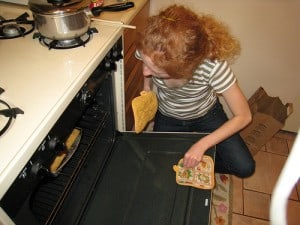
Most American main course recipes recommend use of a conventional oven. Yet most of the energy used by your oven goes to heating up the air inside the oven and around it. Conventional ovens tend to be large and take a long time to get hot, and they are not the most efficient way of cooking.
Ovens have a temperature control and a thermostat. When you set the temperature, the oven operates at full power for as long as it takes to get about ten degrees hotter than the temperature you set. Many ovens have an indicator that lights up when the heating element is on. So the most energy is used when you turn the oven on and the elements are running continuously.
Once the oven is at the desired temperature it takes less energy to maintain. Here are some ways to use the least amount of energy when cooking with an oven.
- Have everything ready, or nearly ready if you are preheating, before turning on the oven.
- Only preheat when necessary, for baked goods. Starting with a hot oven also keeps grated potatoes white. Most casseroles and meats can be put in immediately, without reheating.
- Avoid opening the oven door, especially when the refrigerator door is open. Many chefs believe that opening the door dries out the food. Better to keep the door closed and skip the basting.
- Fill the oven to its full capacity. Even better, make enough food to fill it up a second or third time. Aim to combine a few days or a week of baking into one long session. But baking uncovered meats and vegetables together may result in meats with a less crispy crust.
- Use baking pans that come with your oven, as they fit perfectly and maximize space.
- Use a thermometer to keep track of the oven’s temperature. Ovens are notoriously inaccurate.
- Experiment with turning the oven off five or ten minutes before the food is finished.
- Use a timer—and your nose—to avoid overcooking. Some ovens can be set to turn off automatically.
- You may not need to set the oven on low to keep food warm—many ovens retain enough heat to keep food hot for half an hour or more, as long as the oven door stays closed.
- Avoid using the oven in the summer, especially if you use air-conditioning. If you must, choose the coolest time of day and keep the kitchen well-ventilated.
- In the winter, open or close the kitchen door depending on where you want the house to be warmest. Leave the oven door open when you are finished, but keep small children away.
- Most casseroles, meats, and vegetables can be cooked in the microwave or on top of the stove.

I’d be interested to know:
– why the oven door should remain shut while the fridge door is open, and
– why better not bake when the a/c is on. Too much load on the electrical system?
Mimi, thanks for visiting. The answer to both is the same. You are putting heating and cooling opposite each other. The a/c and the refrigerator expend a lot of energy to keep the room/food cold. They are set to keep the air at a certain temperature, more or less. If they are working well, they will do that. But when the oven is on, the house is hotter and the a/c’s motor will have to generate cool air for longer. It will cost you electricity.
Every time you open the fridge, a drastic change occurs in the temperature of the air in the fridge. That’s why you often hear the motor go on when you open it for more than a few seconds. The idea is not to let that blast of hot air from the oven head straight into your fridge. The more distance between the two, the less of an issue, but they still affect each other. It works in reverse too–the cool air from the fridge will make your oven have to work harder.
Very logical – thanks!
Sorry for posting so late, I just discovered the new blog
I agree with the last point. The best way to cut electricity costs for the oven is to not use it! When I use it I line all my baking one after the other one. If I baked parve (bread, desserts and side dishes) on thursday I will not turn it on just for a chicken on thursday. Instead make the chicken on the stove on a pressure cooker. It takes me 20 minutes on the lowest fire. Some weeks I manage the entire week without turning on the over for more than 3 hours. Baked beans can be ready in less than 2 hours on the stove instead of the oven, etc.
Rachel, and I’m sorry that the comment notification went to my spam folder. Thanks for visiting!